
A mushroom or toadstool is the fleshy, spore-bearing fruiting body of a fungus, typically produced above ground, on soil, or on its food source. Toadstool generally denotes one poisonous to humans.

Agaricus bisporus, commonly known as the cultivated mushroom, is a basidiomycete mushroom native to grasslands in Eurasia and North America. It is cultivated in more than 70 countries and is one of the most commonly and widely consumed mushrooms in the world. It has two color states while immature – white and brown – both of which have various names, with additional names for the mature state, such as chestnut, portobello, portabellini, button and champignon de Paris.

Agaricus xanthodermus, commonly known as the yellow-staining agaricus, yellow-staining mushroom or yellow-stainer, is a mushroom of the genus Agaricus, which displays a strong yellow colouration at the base of the stem when cut. It has a phenolic smell. It is poisonous for most people, causing gastrointestinal upset, but can be eaten by some without apparent negative effect.

In mycology, a partial veil is a temporary structure of tissue found on the fruiting bodies of some basidiomycete fungi, typically agarics. Its role is to isolate and protect the developing spore-producing surface, represented by gills or tubes, found on the lower surface of the cap. A partial veil, in contrast to a universal veil, extends from the stem surface to the cap edge. The partial veil later disintegrates, once the fruiting body has matured and the spores are ready for dispersal. It might then give rise to a stem ring, or fragments attached to the stem or cap edge. In some mushrooms, both a partial veil and a universal veil may be present.
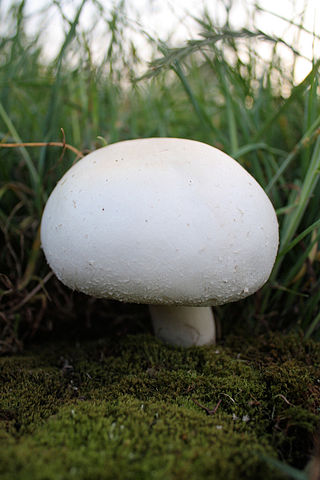
Agaricus arvensis, commonly known as the horse mushroom, is a mushroom-forming fungus of the genus Agaricus.

Agaricus campestris is a widely eaten gilled mushroom closely related to the cultivated A. bisporus. A. campestris is commonly known as the field mushroom or, in North America, meadow mushroom.
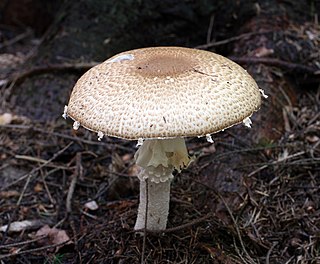
Agaricus augustus, known commonly as the prince, is a basidiomycete fungus of the genus Agaricus.
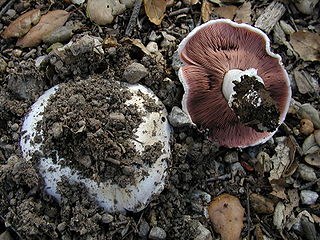
Agaricus bitorquis, commonly known as torq, banded agaric, spring agaric, banded agaricus, urban agaricus, or pavement mushroom, is an edible white mushroom of the genus Agaricus, similar to the common button mushroom that is sold commercially. The name supersedes Agaricus rodmani.

Clitocybe nebularis or Lepista nebularis, commonly known as the clouded agaric, cloudy clitocybe, or cloud funnel, is an abundant gilled fungus which appears both in conifer-dominated forests and broad-leaved woodland in Europe and North America. Appearing in Britain from mid to late autumn, it is edible, but may cause gastrointestinal issues.

Agaricus bernardii, commonly called the salt-loving agaricus, or salty mushroom, is an agaric fungus in the family Agaricaceae. The mushroom's thick stem is usually shorter than the diameter of the cap, which ranges from 5–15 centimetres and is convex to flattened. The cap surface is whitish to buff, and can develop scales or warts in age. The gills are initially pink before turning brown when the spores mature. The flesh turns reddish when it is cut or bruised. It resembles species such as A. bitorquis.
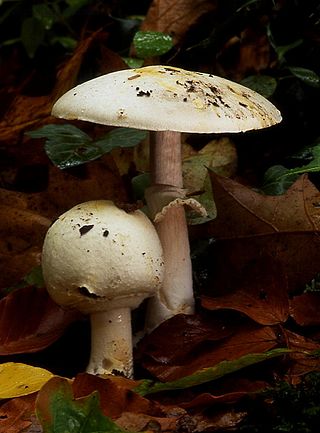
Agaricus silvicola, also known as the wood mushroom or woodland agaricus, is a species of Agaricus mushroom related to the button mushroom. A. silvicola is a member of Agaricus section Arvenses, a group of morphologically similar mushrooms. A. silvicola, like other species in Agaricus section Arvenses, exhibits a positive Schäffer's reaction and potassium hydroxide reaction, and smells of almonds or anise.

Leucoagaricus leucothites, commonly known as the smooth parasol, woman on motorcycle, ma'am on motorcycle, white dapperling, or white agaricus mushroom, is a species of agaric fungus. The species was originally described as Agaricus leucothites by Carlo Vittadini in 1835, and bears similarity to species of that genus. Solomon Wasser transferred it to Leucoagaricus in 1977. While sometimes regarded as edible, the species is suspected of being poisonous due to gastric-upset-causing toxins. It could also be confused with the deadly Amanita ocreata.
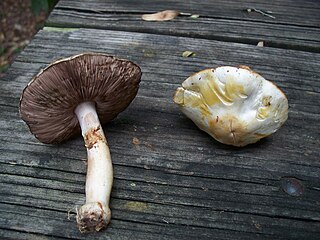
Agaricus abruptibulbus is a species of mushroom in the genus Agaricus. It is commonly known as the abruptly-bulbous agaricus or the flat-bulb mushroom. First described by the mycologist Charles Horton Peck, this bulbous-stemmed edible species smells slightly of anise or bitter almond, and turns yellow when bruised or cut. The mushroom is medium-sized, with a white, yellow-staining cap on a slender stipe that has a wide, flat bulb on the base.

Agaricus deserticola, commonly known as the gasteroid agaricus, is a species of fungus in the family Agaricaceae. Found only in southwestern and western North America, A. deserticola is adapted for growth in dry or semi-arid habitats. The fruit bodies are secotioid, meaning the spores are not forcibly discharged, and the cap does not fully expand. Unlike other Agaricus species, A. deserticola does not develop true gills, but rather a convoluted and networked system of spore-producing tissue called a gleba. When the partial veil breaks or pulls away from the stem or the cap splits radially, the blackish-brown gleba is exposed, which allows the spores to be dispersed.

Clavaria fragilis, commonly known as fairy fingers, white worm coral, or white spindles, is a species of fungus in the family Clavariaceae. It is synonymous with Clavaria vermicularis. The fungus is the type species of the genus Clavaria and is a typical member of the clavarioid or club fungi. It produces tubular, unbranched, white basidiocarps that typically grow in clusters. The fruit bodies can reach dimensions of 15 cm (5.9 in) tall by 0.5 cm (0.2 in) thick. Clavaria fragilis is a saprobic species, growing in woodland litter or in old, unimproved grassland. It is widespread throughout temperate regions in the Northern Hemisphere, but has also been reported from Australia and South Africa. The fungus is edible, but insubstantial and flavorless. There are several other small white coral-like fungi with which C. fragilis may be confused.

Lactarius rufulus, commonly known as the rufous candy cap, is a species of fungus in the family Russulaceae. The fruit bodies have fleshy brownish-red caps up to 10 cm (3.9 in) wide, and closely spaced pinkish-yellow gills. The stem is up to 12 cm (4.7 in) long and 3 cm (1.2 in) thick and colored similarly to the cap. The species, known only from California, Arizona, and Mexico, grows on the ground in leaf litter near oak trees. The fruit bodies resembles those of L. rufus, but L. rufulus tends to grow in clusters at a common base, rather than solitarily or in groups. A distinguishing microscopic characteristic is the near absence of large, spherical cells called sphaerocysts that are otherwise common in Lactarius species. Lactarius rufulus mushrooms are edible, and have an odor resembling maple syrup. They have been used to flavor confections and desserts.
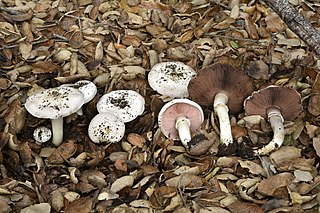
Agaricus californicus, commonly known as the mock meadow mushroom, or California agaricus, is a poisonous mushroom in the section Xanthodermati of the genus Agaricus.

Hygrophorus purpurascens, commonly known as the purple-red waxy cap, is a species of agaric fungus in the family Hygrophoraceae. Its cap has a pink background color with streaks of purplish red overlaid, and mature gills have red spots.
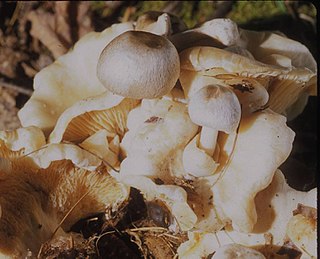
Volvariella surrecta, commonly known as the piggyback rosegill, is an agaric fungus in the family Pluteaceae. Although rare, the species is widely distributed, having been reported from Asia, North America, Northern Africa, Europe, and New Zealand. The fungus grows as a parasite on the fruit bodies of other gilled mushrooms, usually Clitocybe nebularis. V. surrecta mushrooms have white or greyish silky-hairy caps up to 8 cm (3.1 in) in diameter, and white gills that turns pink in maturity. The stipe, also white, is up to 9 cm (3.5 in) long, and has a sack-like volva at its base.
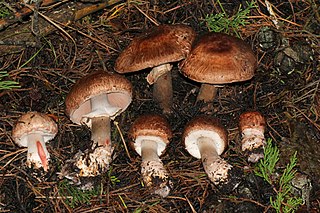
Agaricus brunneofibrillosus, commonly known as the dusky mushroom or bleeding agaricus, is a mushroom in the family Agaricaceae. It has a medium to dark brown cap up to 6 cm (2.4 in) in diameter with brownish fibrillose scales that darken in age. The tightly-packed gills are initially cream colored before becoming pinkish, lilac-gray, and finally brownish as the spores mature. The stout stem is enlarged to bulbous at the base which has one or more brown bands, and a white, membranous ring. The mushroom is edible, and has a pleasant odor similar to button mushrooms, and tastes similar to Agaricus bisporus when cooked.




















